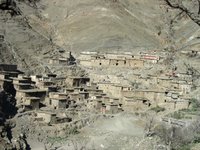
I spent the last week with a family of 5 in a small community of 50 households (many related) that is located in the rolling hills in southeast Morocco. The infrastructure of the community includes the following; electricity, running water, 3 natural springs, one hanut (store), a glis (french hotel), and a mosque. The towns staple is farming that’s done in a valley, courtesy of the springs, while their houses are up the hill in an arid region that seems to have more rocks than soil. It’s a beautiful community though and the residential area makes me think of grandma’s in western Kansas because of some of the landscape, the wind gusts, and solitary nature. Another volunteer described it as “Peace Corps Mars” for its rock, clay floor plan. Walking through the cultivated lowlands, however, is like nothing I’ve ever experienced and features ancient farming practices like hand dug irrigation ditches, small fields, and multi-crop planting laid beneath numerous palm trees. While my friend Graham described the housing area as Mars, this fertile lowland seemed biblical.
My family I stayed with included my host mother Sfia, sister Fatiha (20), and brothers Brahim (18) and Abdlouwahad (15). I have not met my host father Lmkki; I’ve been told he’s a tour guide and is probably in the countryside with some French tourists. The rest of my family is very nice and is very supportive of my language deficiencies. There are few words to express the anxiety one first has when sitting in a room full of Arabic speakers and having nothing to say after you’ve exhausted all of your vocabulary in the previous introductory five minutes. Last week had to have included a thousand myzein (good), zwina (nice), shukran (thank you), snu hadak (what is that), and mafhmtsh (I dont understand). Language is frustratingly slow, probably because we only spend about 4 hours a day on it, we are learning arabic script, and because the pronunciation is so different. I believe there are like eight phonetic sounds in arabic that have no english equivalent, a couple of which are like someone coughing up phlegm. Another one is like saying G-R-H all at the same time, often with another constant coming before the letter.
Overall, it was a great week, just challenging. We traveled back to the hotel 40 km away on Sat, had Sun off, did technical and language training on Mon, and will head back to site this afternoon. I’ll be their again till Sat, then will head somewhere yet unknown for a week thereafter on a field trip to explore the countryside and get more technical training. My next full day off will be in three weeks. In all, the whole experience has become more intense now; instead of a collegiate summer camp as described early, it feels a little like boot camp. This is what I expected though.
In my next post, next week, similar time, I’ll try to provide more info about my experience with my host family. It’s intense and is worth detailing. Otherwise, email me.







